gem-news-2006-v2

July – October 2006
- Other October News – Oct 30
- October 2006 Newsletter – Oct 20
- September 2006 Newsletter – Sep 14
- Other August News – Aug 23 & 24
- August 2006 Newsletter – Aug 16
- Other August News – Aug 3 & 8
- July 20, 2006 Newsletter
- July 4, 2006 Newsletter
Other October News
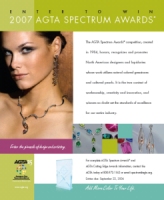 |
October 30: AGTA Announces Gem Spectrum Awards
The American Gem Trade Association announced October 25 the winners of its 2007 AGTA Spectrum Awards.
These awards traditionally are given to designers who are on the cutting edge of the industry, but beginning this year a new Classical category honors “[a]rtists working in time honored techniques and long established aesthetics... that which is familiar and yet exceptional.”
Among the winners were many friends and clients of Pala International. We offer all of you our congratulations. A complete list of awardees is available at the AGTA website. [back to top]
October 2006 Newsletter
Shows and Conferences
- Mineralientage München, November 3–5, 2006
- 1st GIT International Gem & Jewelry Conference: Dec. 5–9, 2006
Pala International News
Gem and Gemology News
Industry News
Shows and Conferences
Mineralientage München
43rd Munich Mineral Show
November 3–5, 2006
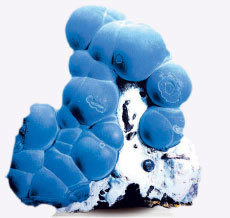 |
| Azurite specimen (Bisbee, AZ) from the special exhibit. |
Pala International’s Bill Larson will attend this major mineral show.
- When: Nov. 3–5, 2006
- Where: Munich Trade Fair Centre, Main Entrance West Halls B1, B2, B3
This year’s special exhibit is titled “Masterpieces: Rembrandts and Picassos of Nature.” It will include a 2000-ct. topaz and the biggest emerald crystal of North America, courtesy the Houston Museum of Natural Science.
For more information visit the show website. See the Pala International Show Schedule for future events. [back to top]
1st GIT International Gem & Jewelry Conference
December 5–9, 2006
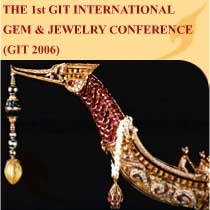 |
This December, Gem and Jewelry Institute of Thailand presents its first International Gem & Jewelry Conference at Bangkok’s Queen Sirikit National Convention Center. It will feature “updates in the fields of gemology such as gem materials, precious metals, gem enhancements, and gem testing techniques.”
The conference also will present panel discussions on Laboratory Manual Harmonization Committee standards and a presentation on paraiba chemical fingerprinting, topics we reported on in last month’s Gem News.
Keynote speakers include Kenneth Scarratt on gem treatment innovation. Other invited speakers include Ahmadjian Abduriyim on chemical fingerprinting of paraiba, Dietmar Schwarz on gemstones of the world, Gamini Zoysa on Sri Lanka, George Bosshart on jade, Grahame Brown on gaja-muthu pearls, Henry Hänni on Tanzania, Karl Schmetzer on Sri Lankan and African taafeites and musgravites, Ken Williams on Raman spectrography and other analysis, Lin Sutherland on metamorphic ruby-bearing gem suites, and Lore Kiefert on demantoid from Iran and coated topaz.
Richard Hughes and Vincent Pardieu, whose travels we mentioned in this month’s Pala Mineral News emailing, also will present, on the topic of “Gem Hunting in Central Asia: Russian Emerald, Tajik Ruby & Spinel.”
The conference will conclude with visits to Chantaburi’s gem market, the Bang Kacha mine site, and gem cutting facilities. [back to top]
Other Shows
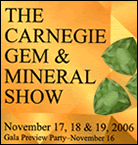 |
Pittsburgh’s Carnegie Museum of Natural History sponsors the 2006 Carnegie Gem & Mineral Show, November 17–19, 2006. Scheduled events include a “Sea of Pearls” pre-show gala, door prize giveaway, and exhibits by dozens of vendors and clubs. [back to top]
Pala International News
Pala’s Featured Stone: Natural Pearl
Made in America!!
This month’s featured stone is sure to appeal to the pearl lover in all of us.
When one thinks of beautiful pearls, visions of exotic far off lands such as Malaysia, French Polynesia, Japan......and Mississippi come to mind?
Yes—Mississippi.
When it comes to collecting, one would include pearls from the North American continent. The waters of Tennessee, Baja California, and even less often, Mississippi have produced pearls that can rival their Oriental cousins.
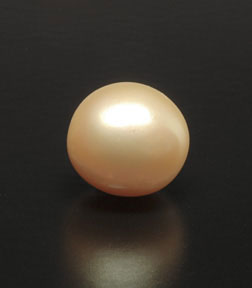 |
| Natural Mississippi pearl. This stone has been sold. (Photo: Wimon Manorotkul) |
This natural beauty weighs 16.84 cts. and measures a full 14 mm. around. It has a lovely cream base with an incredibly full, satin-peach overtone. A pearl such as this is a rare get for any connoisseur.
Please give us a call regarding other rare pearls we have in stock. [back to top]
Larsons in China
Last week, Pala International President Bill Larson and his son Will Larson made presentations at the inaugural gathering of the International Minerals & Gem Crystal Conference and Exhibition, held in Beijing, China.
We’ve assembled the following for our Gem News readers:
- Abstracts and photos from the presentations
- A pictorial of the Larson’s visit to the Forbidden City’s Palace Museum, including an 18th century jewel-encrusted clock and a massive jade carving from the time of Genghis Khan
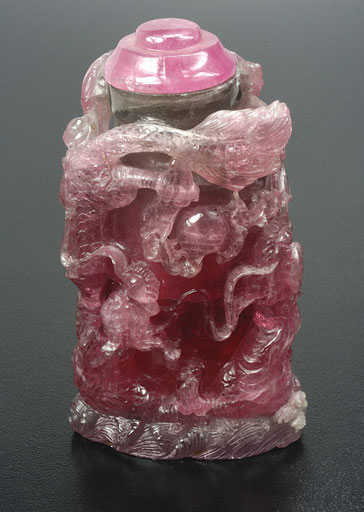 |
| Early 20th century tourmaline snuff bottle, from the Tourmaline Queen Mine, Pala, CA. In his presentation, Bill Larson explained the connection between China and the San Diego County tourmaline mines. (Photo: Wimon Manorotkul) |
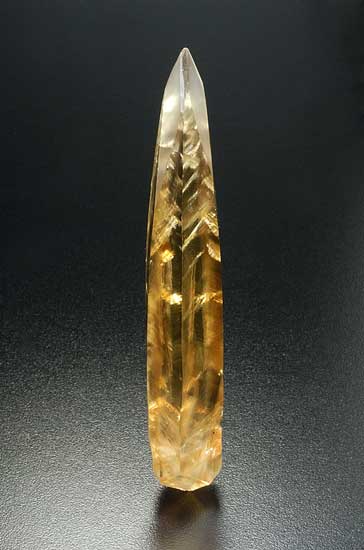 |
| This calcite crystal, from Sweden, is one of several Will Larson used in his presentation to demonstrate to the novice collector the variety available in a single species. (Photo: Wimon Manorotkul) |
[back to top]
Gem and Gemology News
Houston Museum to Open Gem Vault November 17
A new permanent exhibit hall at the Houston Museum of Natural Science, The Lester and Sue Smith Gem Vault, opens November 17. Just as the museum’s Cullen Hall of Gems and Minerals features specimens in their natural state, the new Gem Vault will feature “what people can then do with these materials,” according to exhibit curator and museum president Joel A. Bartsch.
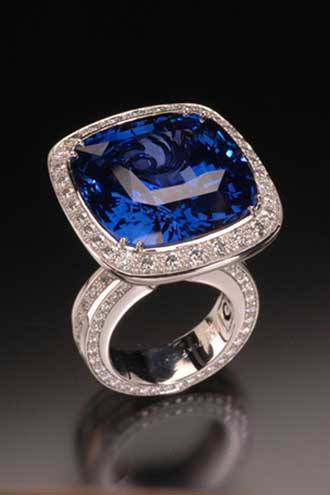 |
| Sapphire ring. This platinum ring has a 62-carat center sapphire surrounded by 4.39 carats of pavé diamonds. (Photo courtesy of the Houston Museum of Natural Science) |
The collection includes the 62-carat sapphire ring (above), designed by Ernesto Moreira, which we mentioned in our August story on the Emmys Red Carpet Jewelry Preview. Moreira was the jewelry designer for the collection. Other highlights:
- A 1,869-carat natural emerald crystal, the largest from North America
- “The world’s finest aquamarine... mined in 1938 only to disappear from history for four decades”
- “The world’s finest tsavorite garnet, a 144-carat gem in that variety’s rarest color—a striking green”
- The 2,765-carat Boulder Opal
[back to top]
Melo Pearls from Myanmar
We’re pleased to offer the abstract of a poster session presentation delivered at the 2006 GIA Symposium in August, entitled “Melo Pearls from Myanmar.” We’ve added several multi-angle photographs of a handful of melo pearls that show the variety that is found in this curious and beautiful non-nacreous pearl.
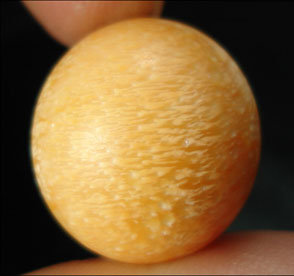 |
| Sea or sky? The flame structure in this 37.89-ct. melo pearl brings to mind choppy waves or tiny clouds, demonstrating one of the many variations available in these compelling creations. |
The presentation was authored by Han Htun (Stalwart Gem Laboratory, Yangon), Pala’s Bill Larson, and Jo Ellen Cole (Cole Appraisal Services, Carlsbad, CA). All you ever wanted to know about melo pearls, from the gastropods that produce them to a few fishermen’s anecdotes (imagine playing marbles with them!). [back to top]
Industry News
Burma Gem Sales and Statistics
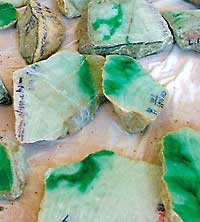 |
Late Summer Sale
Burma held the 21st Gems and Jade Sales 2006 of the Union of Myanmar Economic Holdings Ltd, August 28–September 1. According to The Myanmar Times, the auction offered 1029 lots of jade and 312 of gems, in the third such sale this year. Buyers numbered 890, including 335 foreigners. The sales figure was not disclosed.
October 2006 Emporium
On September 14, YangonCity.com reported on the “mid-year” gem emporium to be held in October. Mid-year sales began in 1992. From their news item:
The sales of pearl lots and gems will be sold at the Myanmar Gems Hall on 21 and 22 October and the sales of the jades will be held at Myanmar Convention Center (MCC) on the rest days. The pearls and the gems will be sell by Euro currency and not only the foreigners but also local traders who possess the license of exploiting the gems and permit to sell the gems can also buy the precious stones, it was learnt.
Gem Entrepreneurs Warned
 |
| Laying down the law. Ohn Myint addresses assembly of gem entrepreneurs in August. Burma continues to rely on increased gem production for much-needed infusions of cash. |
On August 19, in an address before gem entrepreneurs, Minister for Mines Brig-Gen Ohn Myint, warned that “companies that fail to sell their products at the gems emporiums will stand less chance in seeking permission to explore gem blocks,” according to the official New Light of Myanmar newspaper.
Holding the emporium meets success year after year due to more cooperation of entrepreneurs since 2003. Myanmar is rich in natural resources including precious stones. So, only systematic exploration of those gems can help improve the State economy. That is why those who are doing gems business are to abide by policies, rules and regulations of the State. As permission for exploration of more new gem blocks is being granted to the entrepreneurs, they are urged to systematically abide by the prescribed laws, for example, paying taxes in time and selling their gems at the emporium without fail.
The minister warned that permit holders “are not to illegally hand over their plots to others.” He also stressed that “environmental conservation is to be considered as a crucial concern” and that mining permit holders “are to follow the instructions on safety, welfare, health and rule enforcement of workers.” Furthermore, he stated that “[n]ecessary assistance is to be rendered to private gems companies to manufacture and sell finished jade and gems,” addressing the lack of value-added products, since most material leaves the country in rough form.
Taxes and Smuggling... and Taxes
Burma is in need of foreign currency due to economic sanctions against the country, among other factors. The increasingly frequent gem auctions are a way to grow legitimate sales in face of a black market that Robert Horn of London-based ASIANaffairs estimated in April 2005 to be “anywhere from 50 to 90 percent of Burma’s jade and gem deals.” But because material is taxed—20% at the pit and another 10% at auction, according to Horn—smuggling continues.
Sale and Trade Statistics – *Updated 4/16/07
NOTE: We’ve added a special page with all the latest statitics here.
Burma gem sales figures aren’t always easy to come by, so we’ve compiled some, from the following sources: AFP = Agence France-Presse; IPG = Irrawaddy; MT = Myanmar Times; NLM = New Light of Myanmar; PD = People’s Daily, China; YCD = Yangon City Development; XNA = Xinhua.
Annual (Spring) and Mid-Year (Fall) Myanma Gems Emporium
- *March 2007 (44th): “biggest ever”—more than $125 million? (AFP)
- October 2006 (15th): estimated at more than $125 million (MT)
- March 2006 (43rd): about $101 million (PD)
- October 2005 (14th): almost 70% of $48 million worth on offer (AFP)
- March 2005 (42nd): unknown sales of $29 million worth on offer (PD)
- October 2004 (13th): nearly $35 million (MT)
- March 2004 (41st): nearly $23 million (€18.5 million) (NLM)
- October 2003 (12th): over $17.9 million (€15.2 million) (NLM)
- March 2003 (40th): over $23 million (Pala)
- October 2002 (11th): topped $30 million (MT)
- March 2002 (39th): about $20 million (Pala)
- October 2001 (10th): about $9.5 million (Pala)
- March 2001 (38th): about $10 million (NLM)
- October 2000 (9th): over $16.5 million, double the previous year (IPG)
- March 2000 (37th): about $25 million, breaking the 1990 record (XNA)
- March 1990 (27th): about $14.8 million, a record until 2000 (XNA)
- Total sales:
Other Sales
- 21st Gems & Jade Sales 2006 (UMEHL, Aug–Sep 2006): 321 jade lots sold, but no sales figures (NLM)
- Myanmar Jade, Gems & Pearls (Jun–Jul 2006): estimated at $125 million, topping the (March) 2006 annual emporium (MT)
Trade Figures (from May 2004 MT special coverage)
- Precious stone exports: about $60 million from Burma
- Private gem trading companies: about 1,000 in Burma
- Tons of jade produced: for fiscal year ending 3/31/03, 10,000—a nearly tenfold increase over FY 1995–96
- Buyers: Thailand buys 90% of Burmese rubies
Production Figures 1988–2005 (NLM; p. 4 of a PDF, poss. slow download)
- Gem blocks: 1988 – 8; 2005 – 635
- Gem production (1000s of cts): 1988 – 126; 2005 – 61,232
- Jade blocks: 1988 – 3; 2005 – 1,202
- Jade production (1000s of kilos): 1988 – 130; 2005 – 14,436
- Pearl camps: 1988 – 2; 2005 – 9
- Pearl production (mommes): 1988 – 8,488; 2005 – 124,207
- Gem/mining joint-venture/profit-sharing with private companies: 10 (PD)
[back to top]
Mogok Tours Discontinued
According to Canadian shareholder activist Eric Snider, writing August 20 on the British Mines and Communities website, Mogok ruby mine tours have been suspended.
The on-again, off-again trips to the ruby mines area at Mogok offered by junta-friendly travel agencies are apparently off-again. Four-day tours from Mandalay, with participants closely vetted by the Tourism and Hotel Ministry were possible for several years on a limited basis, but, even though they are still advertised on websites, Mogok visits are currently not being allowed.
[back to top]
— End October Newsletter • Published 10/20/06 —
September 2006 Newsletter
Pala International News
Gem and Gemology News
- GIA Symposium 2006: High Points, Low Points
Bill Larson recounts his personal highs and lows - Paraiba Follow-up
- Lab Trade Groups Take On Paraiba
- GIA Symposium: “The Gloves Came Off”
Paraiba was a topic of discussion on Symposium panel
- LIBS Follow-up
Pala International News
Pala’s Featured Stone: Purple Tourmaline
These stunning purple tourmalines are yet another example of the fine material coming from Mozambique. It seems we are seeing more and more magnificent colors from this deposit.
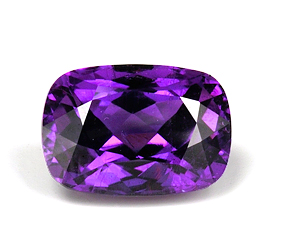 |
| Purple tourmaline, 16.5 ct. This stone has been sold. (Photo: Wimon Manorotkul) |
These two stones are both clean, well cut, and show a purple color unlike we have ever seen before. Even more remarkable, both are natural and unheated.
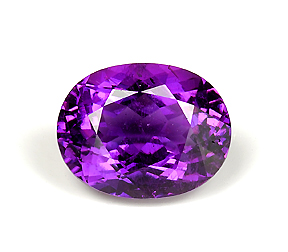 |
| Purple tourmaline, 9.92 ct. Inventory #13731. (Photo: Wimon Manorotkul. Note: In our emailed newsletter this stone was misidentified as an emerald cut 6.61-ct. purple tourmaline, Inventory #13733.) |
Interested? Select the inventory link above for pricing, email us, or give us a call. [back to top]
Gem and Gemology News
GIA Symposium 2006: High Points, Low Points
 |
| On the horns of a dilemma. Bill Larson prepares for his talk in The Jungle debate room’s symposium panel, “Locality of Origin – Does it Really Matter?” |
Last month, the Gemological Institute of America (GIA) held its International Gemological Symposium, only the fourth such event in three decades. The occasion marked GIA’s 75th anniversary. Pala International President Bill Larson was there as both attendee and panelist. We asked him to recount the highs and lows, as he saw them.
- High: Pre-Symposium mine trip to the Pala pegmatite district near Pala International’s Fallbrook office
- High: Record attendance at the pre-Symposium Gemological Research Conference
- High: The very interesting and diverse poster session, with almost 100 presenters!
- High: Opening ceremony; the 12-minute film was done perfectly
- High: Remembering Vince Manson’s conception of Symposium, which he pioneered in 1982. The late Dr. Manson was GIA’s Director of Strategic Planning, affectionately known as GIA’s “Director of Dreams”
- High: Standing ovation for Bill Boyajian, GIA’s recently departed president
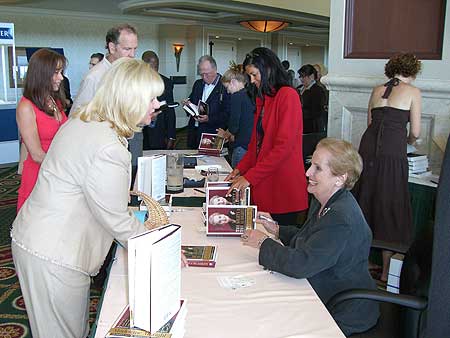 |
| Two Georgetown Hoyas. Madeleine Albright (seated) and Jeanne Larson discussing international affairs as well as their latest brooches. |
- High: Keynote address by Madeleine Albright
- Low: Allowing non-industry related questions (i.e., political) to be asked of Madeleine Albright during post-keynote Q&A
- High-Low: The “Oh **ck” utterance by a certain Greek speaker, heard ’round the room, when he lost his place
- High-Low: The Martin Rapaport “meltdown” (you had to be there) enjoyed—or not—by all attending his panel “Diamonds: Mapping the Future”
- Highest: The GIA 75th Anniversary bash at the Carlsbad headquarters... showing off the new museum displays, the redone rotunda, great wine and food, and then Chris Isaak LIVE!! And fireworks! It doesn't get any better than this...
 |
| Birthday bashers. Jeanne Larson with Phoenix jeweler and designer Alfredo Molina (left) and Jeff Post, Curator of the Smithsonian National Gem and Mineral Collection. |
- High: Diverse topics presented by leading expert speakers from around the world
- High: Commentator Sir Ken Robinson, on the panel “Reinventing Your Business: More than a Makeover”
- High: Keynote by Deepak Chopra, with impeccable humor and timing
- High: Intense debates in “The Jungle,” “The Ring,” and “The Pit”; for more on this see below
- High: Evening dinner with Beach Boys music and synchronized swimmers!
- Low: Maurice Tempelsman’s closing keynote, or “Requiem for a Diamond Dealer”
- Lowest: Maurice Tempelsman reminding the gracious GIA hosts that he was still pursuing a patent infringement lawsuit against them
 |
| Living fountain. Jeanne Larson and acclaimed gemstone photographer Erica Van Pelt stand in front of a live female statue encrusted with diamonds, at the GIA’s 75th birthday party. |
- High: Thanking Symposium Co-Chairs Kathryn Kimmel and Alice Keller for a job well done
- Low: Forgetting to even mention Bill Boyajian in the closing ceremony
- High: The entire GIA 2006 Symposium and amazing staff efforts to make it just plain PERFECT!
- High: Dreaming the next Symposium
- Higher: Italian jewelry fashion show and dinner. Once again, Robin Lewis shows her class as the hostess. Tutto bene!
- High: Post-Symposium mine trip. Sold out, and happy campers all!
- High: Over 120 Symposium attendees visited Pala International’s headquarters on the day after
For some in-depth reporting on the Symposium, including photos galore, see Pricescope.com. A brief overview also appeared in this IDEX Online item. [back to top]
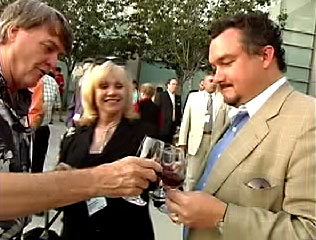 |
| Bill and Jeanne Larson compare legs on California varietals with Austrian attendee at the GIA’s 2006 Symposium. |
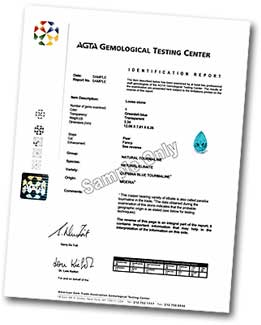 |
Paraiba Follow-up
Following up on last month’s overview of paraiba-type tourmaline, we’re providing examples of wording and nomenclature used by several high-profile labs in their reports.
At issue is whether copper-bearing (or cuprian) tourmaline, regardless of its provenance, should be labeled “paraiba” (after Paraíba, the Brazillian state and locality of its first discovery).
We begin with how laboratory trade groups around the world have addressed the subject and then demonstrate how several labs are putting the trade group agreements into practice.
We end with sample reports from the labs. See the story here. [back to top]
GIA Symposium: “The Gloves Came Off”
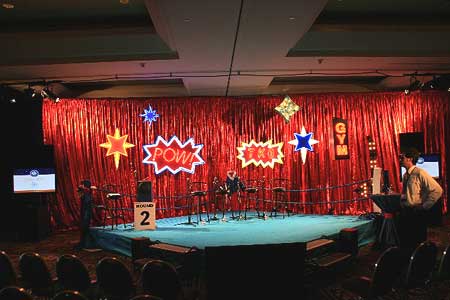 |
| The Ring: One of the three debate rooms at the GIA Symposium. (Photo: Jonathan Weingarten/Good Old Gold) |
Paraiba was a topic of discussion in last month’s GIA Symposium session session featuring Pala International President Bill Larson—and held in one of three debate rooms: The Pit, The Ring, and The Jungle.
According to John Pollard of diamond jewelry retailer Whiteflash.com, “No recording devices or photography were allowed while the sessions were active, and attendees agreed to keep specific details of the discussions confidential in order to stimulate candid, open conversation—with strong opinions encouraged.” Colored Stone, however, seems not to have received the warning:
The first—and most contentious—of the two related to colored gemstones was a session titled “Locality of Origin – Does it Really Matter?” Panelists included three laboratory gemologists, a wholesale gemstone dealer, and the head of an independent retail chain.
Although the session began with general comments from the panel, as soon as the word “Paraiba” was mentioned, the gloves came off.
“I know a great deal about tourmaline,” said panelist William Larson of Pala International, whose company was founded to market tourmaline from the Pala Mine in California. “If you take 10 people and ask them about Paraiba tourmaline, one will say the mine and nine will say the color. Paraiba has gone beyond, it’s transcended its origin [and become a term for a color].”
“From a retail point of view,” agreed fellow panelist Alfred Molina of Molina Fine Jewelers, “I understand Paraiba is a source, but it’s really more of a variety today. From a consumer standpoint, they’re buying the romance.”
The lab reps on the panel had their say, too.
The laboratory representatives were all members of the Laboratory Manual Harmonization Committee (LHMC)... The LHMC had agreed earlier this year to certify all copper-bearing tourmaline, regardless of origin, as “Paraiba” tourmaline. When one audience member called for unity in the trade on the Paraiba issue, [Dr.] Lore Kiefert, head of the American Gem Trade Association Gem Testing Center (AGTA GTC), pointed that out.
“The labs came to a conclusion,” she said, “but there were some individuals in the AGTA community that made this not happen straight away. The labs are okay with it, believe me.”
“If it happens that Paraiba becomes a color location,” asked another audience member, “then what happens to Kashmir [sapphire]?”
You’ll have to read the story to see how the lab reps answered that one. But the article indicated that the debate will continue for some time.
Will all origin labels go the way of “Paraiba” and become indicators of color and quality rather than geographic origin? The answer from panel members was that it all depended on consumer demand; left unanswered was the question of where consumers will get their information on the subject.
For a visual montage of the symposium visit the Symposium website. If you're quick, you’ll catch Bill and Jeanne Larson. [back to top]
LIBS Follow-up
Last month we reported on AGTA’s Gemological Testing Center (GTC) announcement of beryllium testing via laser-induced breakdown spectroscopy (LIBS). What we didn’t mention is the lab’s acknowledgement that “the LIBS laser leaves small circular depressions on the surface of the sample tested. These are generally visible only under magnification and are easily removed by repolishing.” A photograph of a pink sapphire at 30x magnification, included at the end of the GTC news item, illustrates the phenomenon.
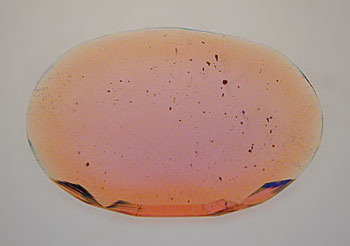 |
| Pink core, orange corona. The orange rim surrounding the pink core of this orange sapphire—telltale evidence of Be treatment—is clearly visible using traditional immersion techniques. Were the beryllium to penetrate the stone fully, however, detection would be difficult and expensive. Just a few ppm of Be can alter a gem’s color. LIBS dramatically reduces the cost of such analysis. (Photo: Richard Hughes/Pala International) |
On August 15, as our previous Gem News was being prepared, the GTC elaborated that a consequence of the testing is “a small eye-visible pit... left on the surface of the gemstone.” The news item explained that “LIBS analysis is normally done on or just below the girdle so that it is difficult to see. Minor repolishing will remove the pit.” For that reason, the GTC requires written authorization to perform the test on all submitted sapphires.
For a late 2002 overview of gem identification technologies, see this Colored Stone article entitled “Dissecting the Atom.” [back to top]
— End September Newsletter • Published 9/14/06 —
Other August News
August 24: Emmys Red Carpet Jewelry Preview Includes 62-ct. Sapphire
 |
Beginning today, Platinum Guild International-USA hosts its Red Carpet Jewelry Preview, in conjunction with the Primetime Emmy Awards, according to a Jewelers Circular Keystone story. The preview provides platinum jewelry from more than 30 designers to stylists as they coordinate red carpet wardrobes.
The story mentions in passing that a 62-ct. sapphire ring by Houston designer Ernesto Moreira, valued at over $850,000, “will be on display with a one-time opportunity to be worn before being put on permanent display at the Houston Museum of Natural Science.” A society column in the Houston Chronicle states that Moreira “who is designing several pieces for the museum’s new Lester and Sue Smith Gem Vault.” A November 2005 Modern Jeweler notice reported that Moreira had “partnered” with the museum, which planned to open the Gem Vault in 2006 as part of its Cullen Hall of Gems and Minerals. “Moreira has been commissioned to create a suite of master work gem designs for the permanent exhibition.”
The celebrities who attend the Jewelry Preview will sign limited edition iPod Nanos for the Clothes Off Our Backs Foundation to auction for charity. The auctions have raised over $1 million for children’s charities since 2002. [back to top]
August 24: AGTA Offers Gemstone Stock Photos
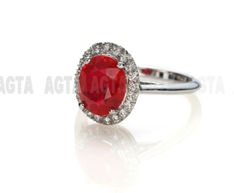 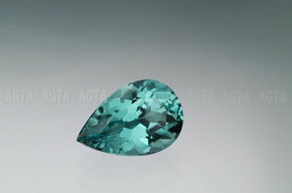 |
| Two examples of stock photos (ruby ring and paraiba tourmaline; click to enlarge) available for licensing from AGTA. The “watermark” is removed from the licensed photo. |
The American Gem Trade Association now offers colored gemstone and jewelry stock photos. They are available in low-resolution and high-resolution formats. The photos appear to be royalty free with payment of the licensing fee. [back to top]
August 23: AGL Acquired by Collectors Universe
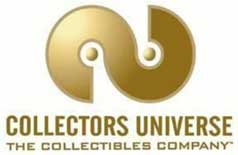 |
On August 21, American Gemological Laboratories (AGL), a colored stone lab based in New York, announced it was acquired by Collectors Universe, Inc, headquartered in Santa Ana, CA. A Collectors Universe press release stated that the company “paid an aggregate acquisition price of $3.5 million in cash for AGL, and, depending on the future financial performance of AGL, may become obligated to make contingent payments of up to an aggregate of an additional $3.5 million over the next five years.”
Collectors Universe, a publicly traded corporation since 1999, bills itself on its corporate overview webpage as “the leading provider of authentication and grading services to the high-end collectibles market.” Its name may not be known to our readers, however, since Collectors Universe is very new to the gemstone market, concentrating primarily on coins and sports cards, according to Hoover’s. AGL is the first colored-stone lab to be added to the Collectors Universe stable of gemstone companies, consisting previously of two diamond firms, both recent acquisitions. (Collectors Universe acquired Gemprint, a non-invasive diamond ID technology, last December, and Gem Certification & Assurance Lab in November.)
AGL was founded by Casper R. “Cap” Beesley in 1977. Beesley is well known to gemstone insiders, building a reputation for being controversial as well as quite influential. “Although his positions have not always been popular, and his assertions often challenged, he exemplifies what it means to take a stand on an important issue, and to persevere for what you believe,” stated gem expert and author Antoinette Matlins in her comments regarding Beesley’s receiving the 2001 Antonio C. Bonanno Award, named after her father, from the Accredited Gemologists Association.
Update 9/14/06: See this Colored Stone story about the acquisition. And National Jeweler has announced that Collectors Universe and AGL will be sponsors of the 2007 Fine Jewelry CEO Summit in Atlanta. [back to top]
August 2006 Newsletter
Show Schedule 2006
- GIA Symposium Features Pala Crystals, Presentation, Aug. 27–29
- Pala at Colorado Mineral & Fossil Show, Sept. 13–17
Pala International News
Featured Article
- World’s Foremost Buys the World’s Finest
GIA Acquires Dr. Eduard Gübelin Collection
Pala’s Bill Larson Recalls His Own Work with the Collection
Industry News
- ICA Issues Mining Report and Lab/Services Directory
- ICA to Use Cert Proceeds for Benevolent Projects
Socially Responsible Payback to Gemstone Producing Countries
Gem and Gemology News
Show Schedule
GIA Symposium Features Pala Crystals, Presentation
August 27–29, 2006
Panel Presentation: “In the Jungle:
Locality of Origin – Does It Really Matter?”
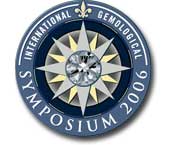 |
Pala International President Bill Larson will present at this year’s Gemological Institute of America Symposium, to be held August 27–29, 2006. Larson will share a panel with Lore Kiefert (AGTA lab director) and Christopher Smith (GIA NY lab research manager), moderated by Gary Roskin (Jewelers’ Circular Keystone Senior Editor).
- When: August 28, 2006
- Time: 4:00–5:30 p.m.
- Where: Manchester Grand Hyatt, One Market Place, San Diego [back to top]
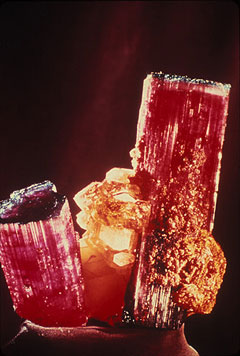 |
| This blue cap tourmaline will be on display in the GIA exhibition. You may recognize it as the specimen pictured on Pala business cards. (Photo: Harold and Erica Van Pelt) |
Exhibition: “Celebrating Excellence in Gems and Jewelry”
At its 75th Diamond Anniversary Gala on the 27th, GIA will unveil a new display setup in the rotunda of the main building of its Carlsbad campus.
The inaugural exhibition, “Celebrating Excellence in Gems and Jewelry,” will include “super fine” local tourmaline and Burma ruby crystals from the collection of Pala’s Bill Larson. GIA sources said a centerpiece display by Symposium Premier Sponsor The Steinmetz Group will be featured as well as highlights from the new Eduard Gübelin collection.
The display system will use state-of-the-art fiber optic lighting, said the sources, and the exhibition’s “excellence” will merit the publication of a catalog, something rarely done by GIA.
Symposium attendees are urged to make time to view the show because, while it runs through November, a limited number of items will be on display only during the run of the symposium itself, GIA sources said. More information will be available, including an exhibition brochure, later in August. [back to top]
Pala at Colorado Mineral & Fossil Show
September 13–17, 2006
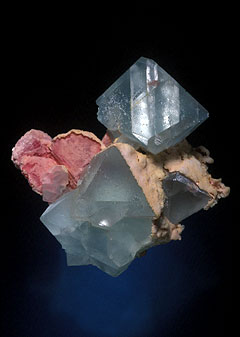 |
| Fluorite-rhodochrosite from Silverton, Colorado, 11.2 cm. (Photo: Jeffrey Scovil) |
Pala International will be at the Colorado Mineral & Fossil Show.
- When: Sept. 13–17, 2006
- Where: Holiday Inn Denver–Central, 4849 Bannock St.
- Room 183
- Hours:
Wed.–Sat.: 10 a.m.–6 p.m.
Sun.: 10 a.m.–5 p.m.
We look forward to seeing our many friends there. For more information visit the show website.
Visit the Pala International Show Schedule for future events. [back to top]
Pala International News
Pala’s Featured Stone
Copper (Cu) bearing tourmaline is all the rage! Not in many years has a gem material caused so much excitement, confusion, and curiosity as has the “paraiba”-type tourmalines from the most recent sources of Mozambique and Nigeria.
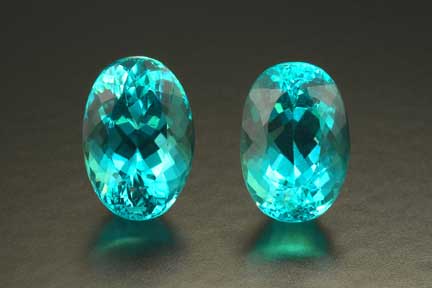 |
| Photo: Wimon Manorotkul |
This lovely pair of ovals, from Mozambique, has many of the same traits of color and chemical composition as its very popular cousins from Brazil. The two weigh a total of 9.94 cts.
Interested? Email us or give us a call.
See our story in this issue about paraiba tourmaline. And you can browse our past featured stones. [back to top]
Pala’s Mineral News
The first issue of our revamped bi-monthly Mineral News was released earlier this month. Featured in this edition are Bill Larson’s Report from Sainte-Marie-aux-Mines 2006, with new specimen photos just added today.
Also see details of a new book, Fine Minerals of China. [back to top]
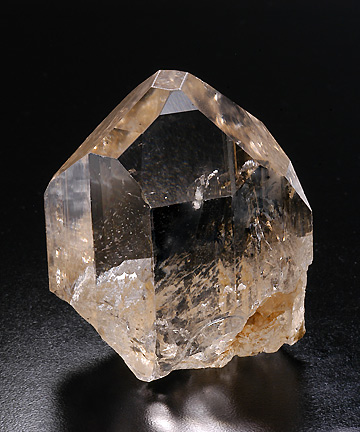 |
| Excellent topaz crystal (4.7 x 5.1 x 2.9 cm). One of several of Bill Larson’s finds at the Ste-Marie show. (Photo: Wimon Manorotkul) |
Featured Article
World’s Foremost Buys the World’s Finest
GIA Acquires Dr. Eduard Gübelin Collection
Pala’s Bill Larson Recalls His Own Work with the Collection
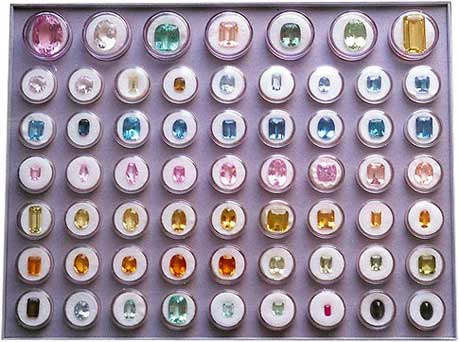 |
| This beryl collection is only one of 70 boxes that comprise the main gemstone collection. (Photo: Edward Boehm) |
- Read the full story here.
The Gemological Institute of America (GIA) has acquired the world famous gem collection of the late Dr. Eduard J. Gübelin. The collection of over 5,000 gem specimens covers all commercial and rare gem species, including organic gemstones such as pearl and amber. Selections from the collection will debut this month at the GIA's 75th Diamond Anniversary Gala.
In addition to its intrinsic value, the collection has educational significance due in part to the numerous locality suites Dr. Gübelin assembled over his esteemed 70-year career. Gem collectors as well as GIA educators will find such features of the collection to be highly useful.
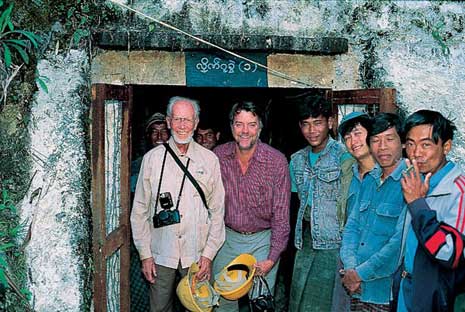 |
| Dr. Eduard Gübelin with William Larson and a group of workers at the entrance to the Lin Yuang Chi ruby mine in Mogok, Burma during a 1993 visit. (Photo: Robert E. Kane, courtesy of Fine Gems International) |
Pala International has had a decades-long relationship with Dr. Gübelin and his collection, culminating in 2001 when Bill Larson, president of Pala International, was hired by Dr. Gübelin to do the first comprehensive, professional-dealer appraisal of the collection. Read Bill’s account of the appraisal process and more on Palagems.com. [back to top]
Industry News
ICA Issues Mining Report and Lab/Services Directory
2006 World Colored Gemstone Mining Report
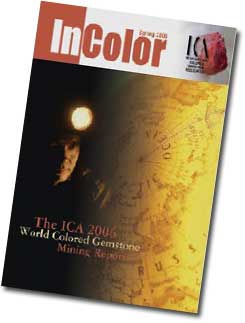 |
The International Colored Gemstone Association (ICA) has issued its 2006 World Colored Gemstone Mining Report, a special edition of its periodical, InColor.
The last such report by the ICA was released in 1995. A press release posted on Jewelers Circular Keystone noted the impact of changes in geo-politics and communications technologies and the rapid spread of exploration and mining, “with many new mining localities establishing themselves, some even becoming dominant and leading sources within a short stretch of time.”
A sample of the report, the section on Burma, is posted on Gemstone Forecaster.
Lab/Services Directory
According to the ICA’s August Membership Newsletter, the next issue of InColor will be “a directory of the gemological laboratories of the world and include their services.” Industry service providers such as shipping companies also will be included.
The issue will be distributed to coincide with the Tucson shows in January 2006. [back to top]
ICA to Use Cert Proceeds for Benevolent Projects
Socially Responsible Payback to Gemstone Producing Countries
Also in the ICA’s August Membership Newsletter, President Joe Menzie acknowledged the donation of computers to Sri Lanka and a post-tsunami home rebuilding project—programs supported by the ICA and its members.
In consultation with international laboratories, the ICA is working on the development of an “ICA Certificate” that would be a “document of guarantee/warranty—a trademark that will reach consumers’ hands.” A portion of the revenue generated from these third-party certificates would “fund special projects specifically identified and defined by the ICA that help people in underdeveloped countries, perhaps in areas where our Gemstones come from.”
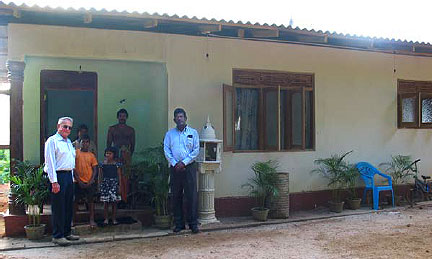 |
| The first home to be built in Sri Lanka as part of the local gem association’s efforts to aid in rebuilding tsunami-hit areas. Top: The home, with some of its family, was constructed for only $2,500 due to the contributions of the architect, Give2Asia, ICA member David Patterson (Geminex), and others. Bottom: In the shadow of the Buddhist temple in Kalutara, Payalgla, stands the new house, next to the hut the family lived in during construction. |
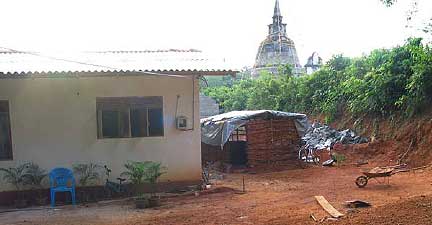 |
The certificates, affordable at $15.00 and less, “would not address the issues of treatments–enhancements but would acknowledge them in a straightforward approach and for further analysis....” [back to top]
Gem and Gemology News
Paraiba at Pala
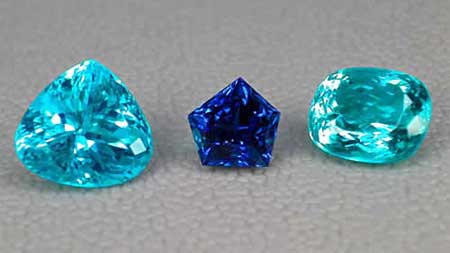 |
| A suite of Brazilian paraiba tourmalines, demonstrating the variety of hues. (Photo: Wimon Manorotkul) |
Much has been written about our featured stone: facetable copper-bearing (or cuprian) tourmaline, often known by the name of “paraiba,” from Paraíba, the tiny, easternmost state in Brazil where the stones were first mined in 1989. Newer deposits of cuprian tourmaline in Africa have created quite a buzz themselves, but have led to some questions regarding labeling.
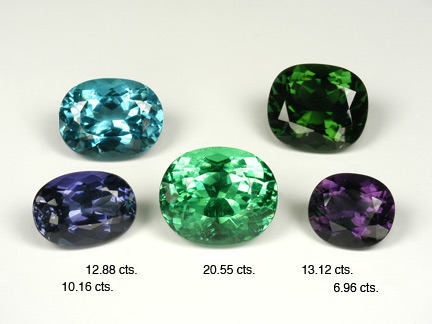 |
| Like their Brazilian cousins, these untreated cuprian tourmalines from Mozambique show a fantastic range of hues. Available from Pala. (Photo: Wimon Manorotkul) |
See the complete article for an overview of the issues surrounding paraiba tourmaline, as well as some samples of the beautiful new material being produced in Mozambique. [back to top]
Be-Diffused Blue Sapphire: Report From Japan
While researching our information on paraiba tourmaline above, we came across a June 2006 research lab report on beryllium-diffused sapphire from the Gemmological Association of All Japan.
 |
| Charlatan’s web? Inclusions are clearly visible using pinpoint illumination. (Photo: Gemmological Association of All Japan) |
“This material, although small in quantity, has already been in the Japanese market,” the report states, “however, it can be recognised by irregular inclusions....” It then points the reader to photographs that illustrate the characteristic circular and web-like inclusions. Inclusions that are invisible using dark-field illumination are clearly seen using strong fiber-optic light. Other identification techniques also are discussed.
AGTA Offers Beryllium Testing via LIBS
Also in June, AGTA’s Gemological Testing Center announced it now offers beryllium testing via laser-induced breakdown spectroscopy (LIBS), using technology first developed at Los Alamos National Laboratories. See this Palagems.com article on LIBS technology.
For earlier reports on beryllium diffusion, see Palagems.com Gem News. [back to top]
— End August Newsletter • Published 8/16/06 —
Other August News
August 8: Boyajian to Head World Jewelry Center
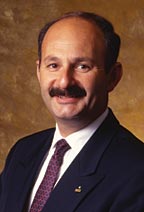 |
Bill Boyajian, the recently-resigned president of the Gemological Institute of America, has been appointed to head the proposed World Jewelry Center (WJC) project in Las Vegas, initiated by Probity International, a Beverly Hills-based real estate investment and development company headed by Robert Zarnegin. A WJC press release, issued last week, was widely reported by National Jeweler and other trade publications.
In the release, Boyajian expressed his enthusiasm: “I am delighted to join the World Jewelry Center project and especially to work with my good friend Robert Zarnegin. Upon announcement of my retirement from GIA, Robert approached me to lead what I believe is the most significant jewelry industry project on the globe.” The release said the center is planned to be the tallest building in Las Vegas, “a global destination complex for consumer jewelry shopping as well as a hub for manufacturers, dealers, trade associations and wholesalers in the gem, jewelry and watch industries.”
Not a done deal. On July 12, the Las Vegas City Council entered into an exclusive 18-month negotiating agreement with the project developer, an affiliate of Probity International Corp., as reported in the local Review-Journal. That report included notes of skepticism on the part of local jewelers. “I don't think it’s feasible,” said Joey Weinstein, pointing to the offshore migration of industry manufacturers that has hurt, among others, the already established Los Angeles Jewelry District. Mordechai Yerushalmi questioned whether the local market could support more competition.
But jeweler Aaron Lelah was upbeat. “Marts draw people who want to buy jewelry. When my family owned a store in the Meadows mall, we did well by being better than the next guy. Competition is healthy.”
According to the Review-Journal article, a previous attempt at creation of a mart near the University of Nevada ended in failure. The present proposal is focusing on 5 acres of the 61-acre Union Park, former site of a downtown railroad yard. [back to top]
August 3: Burma Special Sale Sets Another Record
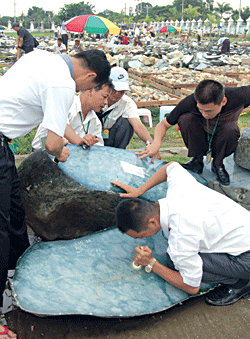 |
Burma set another record with its most recent jade, gem, and pearl sale, according to a July 17 report posted on the Yangon City Development website. Displayed during the sale, which was held June 20 to July 2, were “3,218 lots of jade, 189 lots of gems, and 500 lots of pearl[s].” Lots sold were 2,301 jade, 30 gem, and 282 pearl.
The report did not specify what “record” was set. Presumably it is the numbers of lots sold, which are greater than those of the March emporium (with the exception of gems)—1,684 jade, 51 gem, and 142 pearl—as we reported. The Myanmar Times noted that the March auction “had been projected to earn the government US$63 million.” The newspaper’s next edition quoted a Myanma Gems Enterprise official as stating, “At previous auctions, we sold only high-quality jade, but this time we sold all sorts of jade, so the volume went up.”
The recent auction was announced in April as a “special sale” in addition to the traditional biannual Gems Emporium auctions. Merchants attending the sale, according to the government’s New Light of Myanmar newspaper, were 403 foreign companies from 10 countries (mainly Thailand and China) and 386 local companies.
Later this summer, the 21st Gem and Jade Sales 2006 will be held August 28 to September 1, according to the government newspaper’s report of July 25. The sale is conducted by Union of Myanmar Economic Holdings Ltd. [back to top]
Call for More Finished Jade
Burma has called for production of more finished jade, according to The Myanmar Times. “The state-owned Myanma Gems Enterprise (MGE) has called on local gem companies to take bigger steps into the valued-added jade market which they say will bring the country more foreign currency than exporting raw jade.” An MGE official said the enterprise would supply cutting, polishing, and sculpting equipment. The products would then be sold through its Gem Trading Centre, which will evaluate the jade and let merchants sell it afterward. The Myanmar Times stated that “[t]he intention behind this process was to prevent undervalued jade leaving the country.” [back to top]
July 20, 2006 Newsletter
Pala International News
Industry News
Pala International News
Pala International’s Featured Stone: Aquamarine
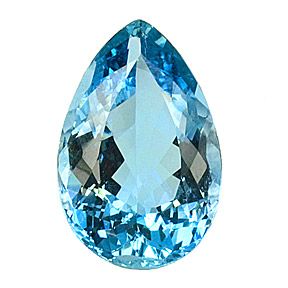 |
Our featured stone is an exceptional aquamarine from antiquarian jewelry, most likely from Santa Maria, Brazil. The immutable aqua color of this gemstone is devoid of the gray found in lesser stones. We dare you to find a finer, darker aquamarine available on the market today.
At 37.60 carats (29.9 x 19.6 x 12.2 mm) this rare stone is perfect for either pendant or investment. The price is available upon request. [back to top]
Larsons to Present at China Show
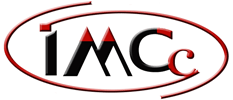 |
Pala President Bill Larson and Bill’s son, Will Larson, are among the thirty international speakers slated to present at the 1st International Minerals & Gem Crystal Conference and Exhibition, China. Bill will speak on tourmaline, one of the great gems of world. He will discuss California production, including the California–China Connection. Will’s topic will discuss what collecting minerals means for the youth of China and America in the 21st century.
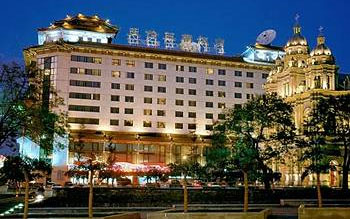 |
| Tianlun Dynasty Hotel, site of the conference and show. |
 |
The show is sponsored by AAA Minerals International, a purveyor of fine Chinese minerals, fossils, and carved stones. It will feature over forty showcases for sponsors and selected enterprises. AAA Minerals also offers purchasing-tours and locality/mine visits, and thus offers two optional mining area tours in Hunan Province before and after the show.
When: October 9–10, 2006
Where: Tianlun Dynasty Hotel, Beijing, China
Optional Tour: Oct. 2–8 or Oct. 11–17
[back to top]
Pala’s Remodel
Visitors to Pala International’s Live Oak Park Road offices might think they’ve stumbled on a sylvan retreat. Until recently, however, a glance in the rear office revealed cramped quarters more along the lines of a monastery cell. But that was then and this is now. Last week we moved part of our operation back into the “back room,” a 488 square-foot renovation, shown in photos below, which took unuseful storage areas down to their footings and transformed them into a spacious workspace. The room provides enhanced workspace for lab instruments, gem photography, communications, and website/database maintenance.
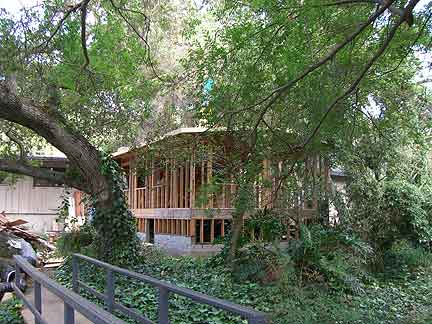 |
| Frame of renovation of Pala International’s Fallbrook, CA, offices. |
The renovation was performed by local contractor Jim Gipner, with assistance by Benjamin Castillo and Salvador Montez. Cabinetry and work surfaces were built by Lee Brown. The remodel includes a new air conditioning unit—much to the relief of us all!
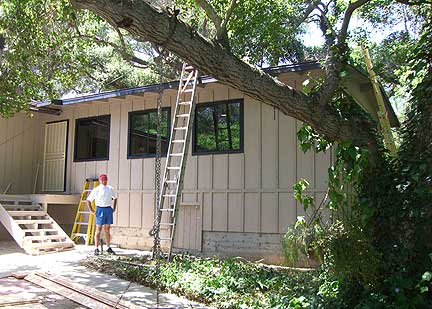 |
| Contractor Jim Gipner stands in front of the remodeled exterior. |
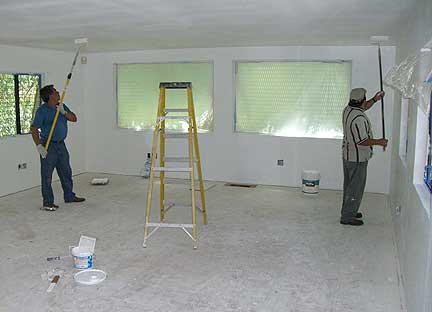 |
| Benjamin Castillo (left) and Salvador Montez paint the interior of the remodeled room. |
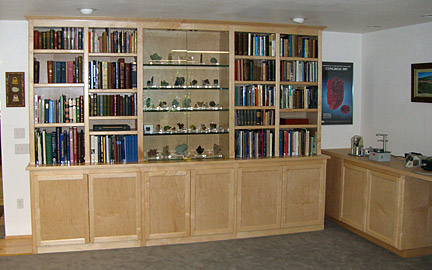 |
| The white maple cabinetry and workspace are a fine reflection of the quality offered by Pala International. |
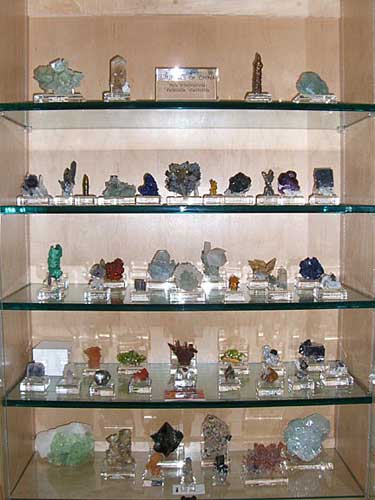 |
| Fifty-three-piece Chinese mineral collection on display. |
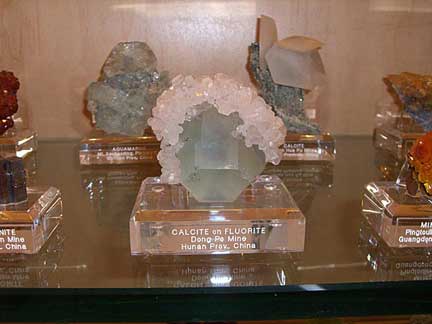 |
| A selection of the Chinese collection mineral specimens. |
[back to top]
Industry News
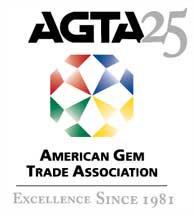 |
AGTA President Takes Leave of Absence
On Juy 17, the American Gem Trade Association (AGTA) announced that its president, Rick Krementz, would take a three-month leave of absence, effective July 17.
The news was released by email, and explained that the leave was due to “calamitous occurrences” in Krementz’s business, apparently unrelated to AGTA affairs. Vice President Barbara Lawrence will fill in during the leave of absence. [back to top]
ICA Poster Competition
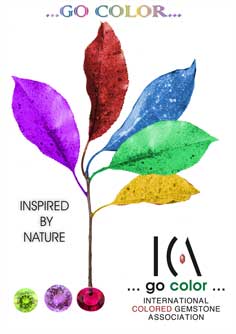 |
Last week the International Colored Gemstone Association (ICA) announced its fourth international poster competition.
According to ICA’s press release, “All entries to the competition will be exhibited during the ICA Congress in Dubai and will be used by the association in its publications to promote colored gemstones worldwide. Each designer may submit up to 3 different poster designs.”
The ICA Congress taking place in Dubai in 2007 marks the first time the Congress will be held in the Gulf region.
ICA officials and members of the public will compose the judging committee and will select the winners. Prizes will be awarded to the top three winners at the Congress Gala Dinner. Posters from the previous competition (such as that pictured at right) can be seen at ICA Poster Competition 2005. [back to top]
— End July 20, 2006 Newsletter —
July 4, 2006 Newsletter
Pala International News
Gem and Gemology News
Featured Article
Pala International News
Pala International’s Featured Stone: African Zircon
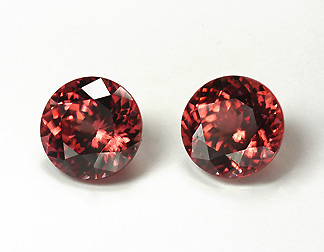 |
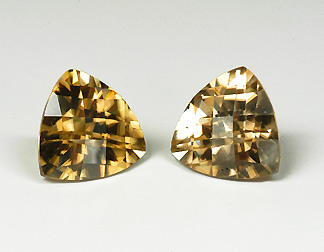 |
As demonstrated by our May and March featured stones, Africa offers a wealth of various gem materials from all regions. Naturally occurring zircon has a brilliance and refractivity very much like that of diamond. Often confused with zirconia, zircon is most well known in yellows and brown-yellows, but new material of unusual and scintillating colors is what we present to you this month.
The zircons pictured above (top, 5.91 ct.; bottom, 10.96 ct.) are examples of the latest colors being produced from Kenya and Tanzania.
Prices are available upon request. [back to top]
Pala International’s Mineral News E-Bulletin
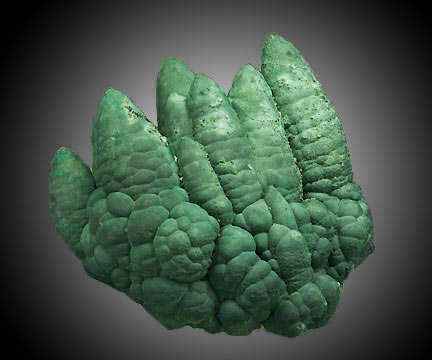 |
Some of you have subscribed to our Mineral News e-bulletin. And you’re probably wondering why you haven’t been receiving it.
We’re pleased to announce the revival of Pala International’s Mineral News. Subscribers to that newsletter can expect the first issue on or about August 1. (Gem News subscribers can sign up using this subscription form.)
Meanwhile, feel free to browse mineral specimens at Pala International’s sister site, PalaMinerals.com. You’ll find much to tempt, such as the malachite cluster pictured above (since sold).
And last month we received word from Ian Bruce of two websites of interest to mineral collectors. Crystal Classics is his own site, featuring British and European specimens amongst others. The second is MinVision, a new venture by Jolyon and Ida Ralph of mindat.org, which allows browsing of multiple dealers at once. [back to top]
Pala at JA New York Summer Show July 30–August 2, 2006
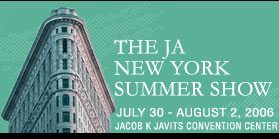 |
Pala International heads to the East Coast later this month for the trade-only JA New York Summer Show. Stop by to see one of America’s largest selections of fine colored gems.
When: July 30–August 2, 2006
Where: Jacob K. Javits Convention Ctr.
Hours: AGTA Gemstone Section
Sunday, July 30: 9:30 AM – 6:00 PM
Monday, July 31: 10:00 AM – 6:00 PM
Tuesday, August 1: 10:00 AM – 6:00 PM
Wednesday, August 2: 10:00 AM – 6:00 PM
Pala International is in booth 1361. Visit the JA New York website for more information. [back to top]
Gem and Gemology News
Christie’s Hong Kong Sets Record
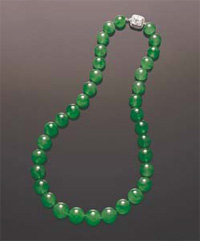 |
On June 1, Christie’s Asia announced it had set a record for “the highest total ever for a jewellery sale in Asia,” according to Vickie Sek, Director of the Jewellery and Jadeite Department.
The sale, which topped US$38 million, marked Christie’s 20th anniversary in Hong Kong.
As remarkable as the jewelry sale was, it’s dwarfed by the entire five-day Hong Kong auction total: US$154 million. As was widely reported, casino mogul Steve Wynn spent US$10 million at the sale for a single Chinese Ming Dynasty-era porcelain vase.
Laurence Graff shopped in the Jewellery Department and picked up a “cushion-shaped Burmese ruby of 9.25 cts.” In a pre-sale press release, Christie’s compared the ring to Graff’s own record-setter, The Graff Ruby (purchased by Graff in February). The new purchase cost him US$1.2 million less, or US$2,418,000—and less per carat: US$260,000/ct, or a total of US$165,000 off of February’s world record.
Seven more of the top ten jewelry sales—heavily dominated by diamonds, but including the Burmese jadeite necklace pictured above—went to Asian buyers. According to a Bloomberg analysis, “‘The Chinese are swooping in and buying all the D-, E-, F-grade diamonds,’ said Benny Pek, 53, an Indonesian jeweler who flew in from Jakarta... ‘The Chinese have become the big shots at these auctions. We can’t compete.’” [back to top]
AGS Introduces Emerald Cut Grade
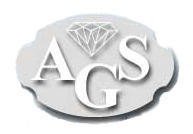 |
On June 20, the American Gem Society (AGS) Laboratories announced they would begin issuing a diamond cut grade for three new shapes: square emerald cut, rectangular emerald cut, and an octagon step cut.
The new cut grade expands further the Laboratories’ innovative Cut-Grading System, introduced last year, which measures all facets of a diamond in three dimensions, thus enhancing the grading in reports. Later that year the AGS released grades for the round brilliant and the princess cuts, a first for a fancy shaped diamond. [back to top]
Featured Article
Australian Gemmologist Reprint: Gemstones in Vietnam
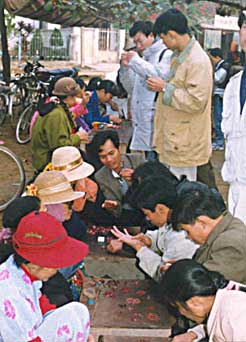 |
The variety and quality of gemstones in Vietnam has been recognized by savvy dealers and collectors since the late 1970s.
Dr. Grahame Brown, editor of the quarterly journal, The Australian Gemmologist, has kindly given Pala International permission to reprint a substantial article entitled “Gemstones in Vietnam.” Written by Vietnamese and French researchers, the article covers corundum as well as aquamarine, tourmaline, peridot, and pearl.
For an update on corundum mining in Vietnam, check out this 2005 article from Vincent Pardieu’s FieldGemology.org. The piece also includes a section on melo pearls. [back to top]
— End July 4, 2006 Newsletter —
Note: Palagems.com selects much of its material in the interest of fostering a stimulating discourse on the topics of gems, gemology, and the gemstone industry. Therefore the opinions expressed here are not necessarily those held by the proprietors of Palagems.com. We welcome your feedback.